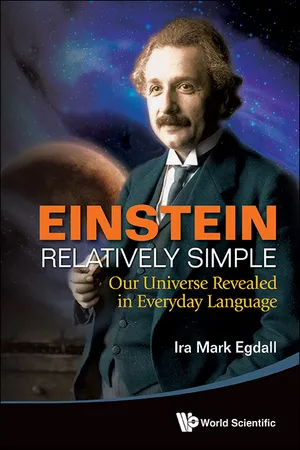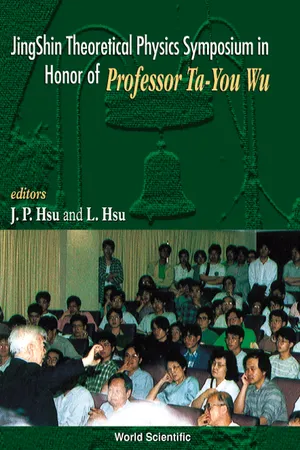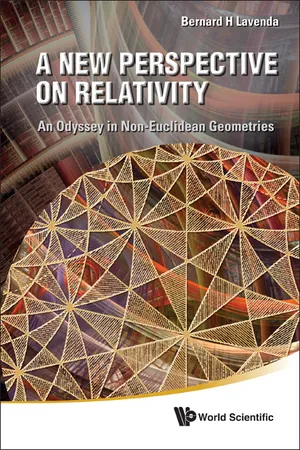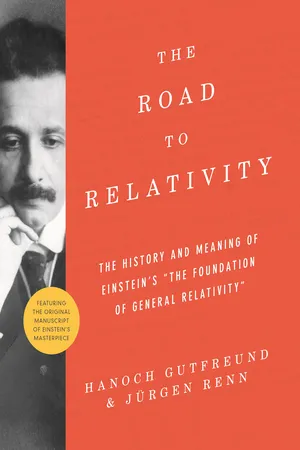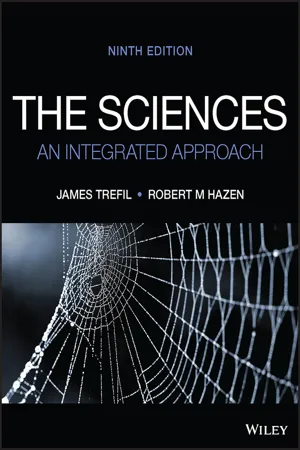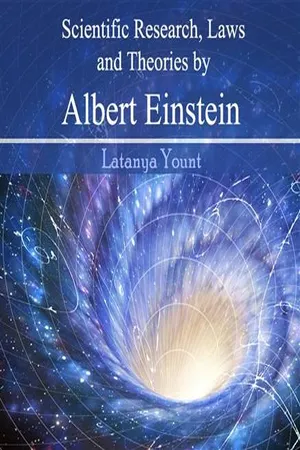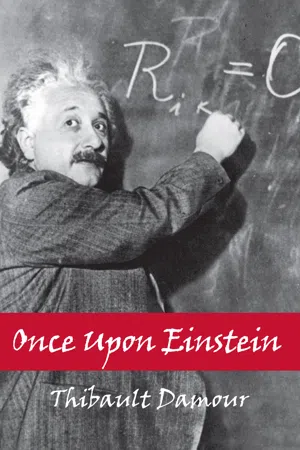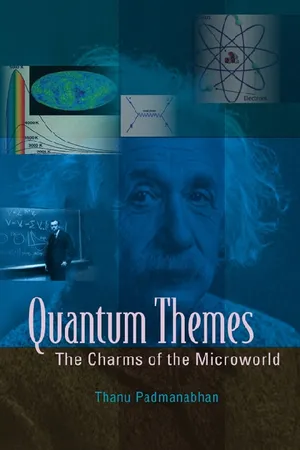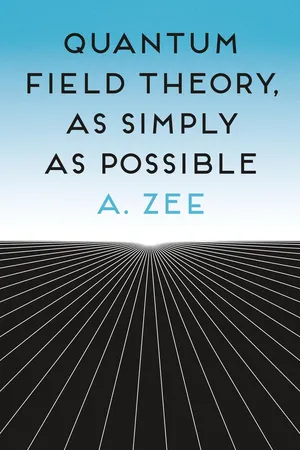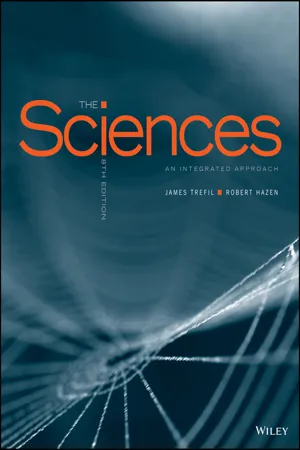Physics
Albert Einstein
Albert Einstein was a renowned physicist known for his theory of relativity, which revolutionized the understanding of space, time, and gravity. His famous equation, E=mc^2, demonstrated the equivalence of mass and energy. Einstein's work laid the foundation for modern physics and had a profound impact on our understanding of the universe.
Written by Perlego with AI-assistance
Related key terms
1 of 5
10 Key excerpts on "Albert Einstein"
- eBook - PDF
Einstein Relatively Simple: Our Universe Revealed In Everyday Language
Our Universe Revealed in Everyday Language
- Ira Mark Egdall(Author)
- 2014(Publication Date)
- World Scientific(Publisher)
Additional information can be found in the suggested reading. Unlike quantum theory, the two theories of relativity were devel-oped primarily by a single individual, Albert Einstein. While cutting class and sipping coffee at cafes in Zurich — later in free moments at the patent office in Berne and at home with his wife Mileva and baby Hans Albert — Einstein pondered the physics issues of his day. He revealed the results of his contemplations in what we now call his “Miracle Year.” E i n s t e i n R e l a t i v e l y S i m p l e 12 1905 — The Year of Einstein In 1905, 26-six-year-old Albert Einstein published three papers in volume 17 of Annalen der Physik (Fig. 1.4) which would resolve conflicts in physics that had escaped all other scientists — and provide humanity with a radi-cal new view of reality. 31 Einstein wrote to a friend that he had produced these papers in his spare time. They were: The Photoelectric Effect — In this seminal paper, Einstein introduced the quantum theory of light to explain the puzzling results of the photo-electric effect. Based on Max Planck’s formulation, Einstein made the radical assertion that light behaves like a particle as well as a wave. Einstein termed his proposition “very revolutionary” and it was. 32 Planck and Einstein’s work gave birth to quantum mechanics — the most accu-rate and strangest theory in the history of physics. Brownian Motion — Scientists had known for at least a hundred years that microscopic dust particles floating on a water surface con-tinuously jiggle, but no one could explain why. Einstein showed this jiggling is due to the thermal vibration of individual water molecules — effectively confirming the existence of atoms and molecules for the first time. Special Relativity — In this manuscript, Einstein proposed the radical notion that space and time are relative. Biographer Roland Clark called this “one of the most remarkable scientific papers ever written. - Jong-ping Hsu, Leonardo Hsu(Authors)
- 1998(Publication Date)
- World Scientific(Publisher)
Innovative Ideas in Physics This page is intentionally left blank 61 Einstein's impact on theoretical physics* Chen-Ning Yang That symmetry dictates interactions, that geometry is at the heart of physics, and that formal beauty plays a role in describing the world are insights that have had a profound effect on current thought Chen-Ning Yang is the Einstein Professor and the director of the Institute of Theoretical Physics at the State University of New York at Stony Brook. ♦Reprint with permission from Physics Today, June 1980, pp. 42-49. Copyright 1980 American Institute of Physics. 62 There occurred in the early years of this century three conceptual revolutions that profoundly changed Man's understanding of the physical universe: he special theory of relativity (in 1905), the general theory of relativity (1915) and quantum mechanics (1925). Einstein personally was responsible for the first two of these revolutions, and influenced and helped to shape the third. But it is not about his work in these conceptual revolutions that I shall write here. Much has been written about that work already. Instead, I shall discuss, in general terms, Einstein's insights on the structure of theoretical physics and their relevance to the development of physics in the second half of this century. I shall divide the discussion into four sections which are, of course, very much related. Symmetry dictates interaction The first important symmetry principle discovered in fundamental physics was Lorentz invariance, which was found as a mathematical property of Maxwell equations, which in turn were based on the experimental laws of electromagnetism. In this process the invariance, or symmetry, was a secondary discovery. In his Autobiographical Notes Einstein gave Hermann Minkowski credit for turning this process around.- eBook - PDF
New Perspective On Relativity, A: An Odyssey In Non-euclidean Geometries
An Odyssey in Non-Euclidean Geometries
- Bernard H Lavenda(Author)
- 2011(Publication Date)
- World Scientific(Publisher)
Chapter 1 Introduction Planck made two great discoveries in his lifetime: the energy quantum and Einstein [Miller 81] 1.1 Einstein’s Impact on Twentieth Century Physics When one mentions the word ‘relativity’ the name Albert Einstein springs to mind. So it is quite natural to ask what was Einstein’s contribution to the theory of relativity, in particular, and to twentieth century physics, in general. Biographers and historians of science run great lengths to rewrite history. Undoubtedly,Abraham Pais’s [82] book, Subtle is the Lord , is the defini-tive biography of Einstein; it attempts to go beneath the surface and gives mathematical details of his achievements. A case of mention, which will serve only for illustration, is the photoelectric effect. Pais tells us that Einstein proposed E max = h ν − P , where ν is the fre-quency of the incident (monochromatic) radiation and P is the work func-tion — the energy needed for an electron to escape the surface. He pointed out that [this equation] explains Lenard’s observation of the light intensity independence of the electron energy. Pais, then goes on to say that first E [sic E max ] should vary linearly with ν . Second, the slope of the ( E , ν ) plot is a universal constant, independent of the nature of the irradiated material. Third, the value of the slope was predicted to be Planck’s constant determined from the radiation law. None of this was known then. This gives the impression that Einstein singlehandedly discovered the photoelectric law. This is certainly inaccurate. Just listen to what J. J. Thomson [28] had to say on the subject: It was at first uncertain whether the energy or the velocity was a linear function of the frequency . . . Hughes, and Richardson and Compton were however able to 1 2 A New Perspective on Relativity show that the former law was correct . - eBook - PDF
The Road to Relativity
The History and Meaning of Einstein's "The Foundation of General Relativity", Featuring the Original Manuscript of Einstein's Masterpiece
- Hanoch Gutfreund, Jürgen Renn(Authors)
- 2015(Publication Date)
- Princeton University Press(Publisher)
Around 1899–1900, Levi- Civita and his professor, Ricci-Curbastro, wrote a fundamental treatise on absolute differential calculus and its applications to express geometric and physical laws in Euclidean and non-Euclidean spaces. Einstein and Grossmann later used and developed these new mathematical tools to formulate the general theory of relativity. In the years 1915–1917, Einstein and Levi-Civita corresponded about mathematical prob- lems of the theory. Lorentz, Hendrik Antoon (1853–1928) The Dutch physicist Hendrik Antoon Lorentz was appointed profes- sor at the University of Leiden in 1877. His most influential contribu- tions concerned the theory of light and electromagnetism as well as the electron theory. Starting from Maxwell’s electromagnetic theory, Lorentz developed his electron theory and, in particular, an electro- dynamics of moving bodies based on the assumption of a stationary ether. Lorentz’s electrodynamics constituted the fundament of Einstein’s special theory of relativity, which, however, disposed of the medium ether. Lorentz recognized the con- sistency of Einstein’s theory and made contributions to it but continued to support the existence of the ether. In later years, Lorentz also contributed to the development of the general theory of relativity. Mach, Ernst (1838–1916) The Austrian physicist and philosopher Ernst Mach was appointed professor of physics at the University of Prague in 1867, and professor for history and philosophy of science at the University of Vienna in 1895. His physical research was dedicated to problems of optics (Dop- pler effect) and acoustics (sound waves). In this connection, Mach also studied the physiology and psychology of sensory perception, on which he published a book in 1886. These studies led Mach to question the mechanis- tic and atomistic views prevalent at the time and to formulate an empirical theory of knowledge that strongly influenced the logical positivism of the twentieth century. - eBook - PDF
The Sciences
An Integrated Approach
- James Trefil, Robert M. Hazen(Authors)
- 2022(Publication Date)
- Wiley(Publisher)
Mass and Relativity Perhaps the most far-reaching consequence of Einstein’s theory of relativity was the dis- covery that mass, like time and distance, is relative to one’s frame of reference. So far we have been faced with three strange ideas: 1. Clocks run fastest for stationary objects; moving clocks slow down. As the speed of light is approached, time slows down and approaches zero. 2. Distances are greatest for stationary objects; moving objects shrink in the direction of motion. As the speed of light is approached, distances shrink and approach zero. Einstein showed that a third consequence followed from his principle: 3. Mass is lowest for stationary objects; moving objects become more massive. As an object’s velocity approaches the speed of light, its mass approaches infinity. Einstein showed that if the speed of light is a constant in all reference frames—which must follow from the central assumption of the theory of relativity—then an object’s mass depends on its velocity. The faster an object travels, the greater its mass and the harder it is to deflect from its course. If a ground-based observer measures an object’s stationary or “rest” mass, m GG , then the apparent mass, m MG , of that object moving at velocity v is m m v c MG GG / [ ( ) ] 1 2 196 Chapter 7 Albert Einstein and the Theory of Relativity Once again, the Lorentz factor comes into play. As we observe an object approach the speed of light, its mass appears to us to approach infinity. This property of mass leads to the common misperception that relativity predicts that nothing can travel faster than the speed of light. In fact, the only thing we can conclude is that nothing that is now moving at less than the speed of light can be accelerated to or past that speed. - No longer available |Learn more
- (Author)
- 2014(Publication Date)
- Orange Apple(Publisher)
This led to the famous mass–energy equivalence formula: E = mc 2 . Einstein considered the equivalency equation to be of paramount importance because it showed that a massive particle possesses an energy, the rest energy, distinct from its classical kinetic and potential energies. As it was shown above, many authors before Einstein arrived at similar formulas (including a 4/3-factor) for the relation of mass to energy. However, their work was focused on electromagnetic energy which (as we know today) only represents a small part of the entire energy within matter. So it was Einstein who was the first a) to ascribe this relation to all forms of energy, and b) to understand the connection of Mass-energy equivalence with the relativity principle. Early reception First assessments Walter Kaufmann (1905, 1906) was probably the first who referred to Einstein's work. He compared the theories of Lorentz and Einstein, and, although he said Einstein's method is to be preferred, he argued that both theories are observationally equivalent. Therefore, he spoke of the relativity principle as the Lorentz-Einsteinian basic assumption. Shortly afterwards, Max Planck (1906a) was the first who publicly defended the theory, and who interested his students Max von Laue and Kurd von Mosengeil for this theory. He described Einstein's theory as a generalization of Lorentz's theory, and to this Lorentz-Einstein-Theory he gave the name relative theory, while Alfred Bucherer changed Planck's notation into the now common theory of relativity. On the other hand, Einstein himself and many others continued to simply refer to the new method as the relativity principle. And in an important overview article on the relativity principle (1908a), Einstein described SR as a union of Lorentz's theory and the relativity principle, including the fundamental assumption that Lorentz's local time can be ________________________ WORLD TECHNOLOGIES ________________________ described as real time. - eBook - PDF
- Thibault Damour(Author)
- 2006(Publication Date)
- A K Peters/CRC Press(Publisher)
We must nevertheless take note of the fact that the context in which these hopes are in part realized is very different from that which Einstein had envisioned. In particular, it is essential to take quantum theory as the point of departure in order to arrive, in string theory, at the phenomena we have just described. Not a Day without Einstein Einstein once lightheartedly said: “They should all be ashamed, those who thoughtlessly make use of the miracles of science and technology, without understanding any more of them than the cow does of the botany of the plants it eats with enjoyment.” Elsewhere he insisted on the fact that the original source of all technical accomplishments is “the divine curiosity and the playful urge of the tinkering and pondering researcher.” Out of respect for Einstein, I would thus like, dear reader, for you to think sometimes of all the commodities and technology of everyday life which have been initiated through Einstein’s playful urge to ponder on the structure of reality. In fact, we note that Einstein was not a pure theorist, having no direct interest in practical applications. Throughout his life, beginning with his laboratory studies in Zurich and his work at the Patent Office, he kept an interest in experimental research and scientific applications. (Recall as well that his uncle Jakob was an engineer who worked, with his father, to develop Not a Day without Einstein 163 the electrification of the city of Munich, and then of the Pavia region of Italy.) In particular, Einstein himself applied for a fair number of patents for various inventions, ranging from an apparatus for measuring small voltages, to hearing aids, a silent refrigerator, and magnetically levitated gyro-compasses. Physics is omnipresent in our environment, and a great part of mod-ern physics has directly issued from the theoretical ideas formulated by Ein-stein. - eBook - PDF
Quantum Themes: The Charms Of The Microworld
The Charms of the Microworld
- Thanu Padmanabhan(Author)
- 2009(Publication Date)
- World Scientific(Publisher)
Chapter 2 And then there was Einstein Thus, at the end of 19th century most physicists felt that they knew all the fundamental laws which govern the behaviour of nature and that they just need to do the calculations more accurately to understand everything. Amidst this complacency there was a prophetic comment from Lord Kelvin. In a Friday evening lecture at the Royal Institution delivered in April 1900, Kelvin stressed that while we do seem to understand most of the physical phenomena in nature, the “beauty and clearness of the dynamical theory” is “at present obscured by two clouds”. The “clouds” he was referring to dealt with the the difficulties in understanding the propagation of light and the specific heats of gases. With hindsight, one cannot but appreciate his genius. At any given time, physicists will be grappling with several unsolved issues and it is never very clear which of them are fundamental and which of them are incidental issues pertaining to details. A great physicist is the one who can concentrate on the deepest of the problems and Kelvin certainly identified the right ones at the end of 19th century. When these two clouds rained, the first one led to relativity (which is the subject of this chapter) and the other led to quantum theory (which we will discuss in the next chapter) thereby heralding two major revolutions of the 20th century physics. Let us begin with relativity. 2.1 Something crazy about light Let us start with the thought experiment similar to the one we briefly discussed in the last chapter. You are sitting inside a car moving forward with a steady speed of, say, v = 60 km/hr. You now throw a ball towards the front of the car with a speed u = 10 km/hr with respect to the moving 37 38 Quantum Themes: The Charms of the Microworld car . - eBook - PDF
- Anthony Zee(Author)
- 2023(Publication Date)
- Princeton University Press(Publisher)
(That last step is just for those of you who insist on not using units in which c = 1.) Incidentally, in modern physics, the relation E 2 − p 2 = m 2 is often taken as the definition of mass. When a hitherto unknown particle is discovered, experimentalists measure its energy E and its momentum p and declare its mass to be the m given by this relation. Of course, this also provides a test of Einstein’s theory; every time experimentalists see this particle, its energy and its momentum may be different, but its mass better be the same, that is, an invariant. The Lord did not lead him around by the nose One more consequence of the paper on electrodynamics has also occurred to me. . . . The argument is amusing and seductive; but for all I know the Lord might be laughing over it and leading me around by the nose. Albert Einstein writing to a friend in 1905 Incidentally, Einstein didn’t have E = mc 2 in his paper proposing special rela- tivity. This famous relation appeared a few months later in a brief note. As we all know, the Lord did not lead Einstein around by the nose. 54 Chapter I.4 Einstein’s original 1905 derivation, in the glare of hindsight, was unnec- essarily complicated. The derivation given here is much simplified. Later in 1946, in a lecture at the Technion in Haifa, Israel, he gave an elegant deriva- tion which surprisingly, is omitted from most textbooks 14 and so is in danger of being forgotten. Interestingly, while Lorentz found the transformation, he was not able to work out the ramifications for physics. It is tempting to hypothesize that this is because Einstein was young at the time while Lorentz was old. Deeper and simpler As physicists explore Nature at ever deeper levels, Nature appears to get ever simpler. The story of relativistic invariance exemplifies this remarkable, and striking, phenomenon. I may surprise the reader by saying that Einsteinian mechanics, once mastered, is intrinsically simpler than Newtonian mechanics. - eBook - PDF
The Sciences
An Integrated Approach
- James Trefil, Robert M. Hazen(Authors)
- 2016(Publication Date)
- Wiley(Publisher)
Thus Newton’s laws represent an extremely important special case of Einstein’s more general theory. Science often progresses in this way, with one theory encom- passing previous valid ideas. Newton, for example, merged dis- coveries by Galileo of Earth-based motions and Kepler’s laws of planetary motion into his unified theory of gravity. And someday Einstein’s theory of relativity may be incorporated into an even grander view of the universe. Can a human ever travel faster than the speed of light, at “warp speed”? • he speed of light, denoted by the symbol c, is nearly 300,000 kilometers per second. It is one of the best-known physical con- stants in science. • In 1905, Einstein published his theory of special relativity, which asserts that the speed of light is a fundamental constant of na- ture. It appears the same to all observers in all frames of refer- ence anywhere in space. • Special relativity asserts that mass is not a constant; as an object increases in speed, it also increases in mass. • As the mass of an object increases, the energy required to in- crease its speed also increases. • herefore, as an object approaches the speed of light its mass would approach ininity and the energy required to accelerate an ininite mass beyond the speed of light would be ininite. • Consequently, no physical object such as a human being or spaceship that is moving at less than the sped of light will ever exceed that speed. RETURN TO THE INTEGRATED QUESTION Every observer sees the world from a diferent frame of reference. Descriptions of actual physical events are diferent for diferent ob- servers, but the theory of relativity states that all observers must see the universe operating according to the same laws. Because the speed of light is built into Maxwell’s equations, this principle requires that all observers must see the same speed of light in their frames of reference.
Index pages curate the most relevant extracts from our library of academic textbooks. They’ve been created using an in-house natural language model (NLM), each adding context and meaning to key research topics.
